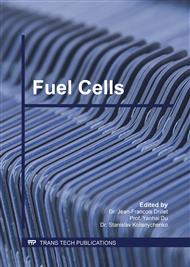p.403
p.410
p.417
p.425
p.431
p.435
p.442
p.449
p.455
Pre-Immobilization of Anaerobic Mixed Culture on Electrode of the Upflow Bio-Filter Circuit Microbial Fuel Cell
Abstract:
Microbial extracellular electron transfer is a significant process in a microbial fuel cell (MFC). Owing to many potential losses in the electron transfer from microorganism to an electrode, a promotion of microbial attachment to electrode should be a productive solution to this difficulty of MFC. We also introduced here a prior colonization of microbes on electrode instead of a conventional immobilization which entirely occurred in a MFC reactor to expedite an attachment of microorganisms on the electrode surface. Coconut shell-based granular activated carbons (CGACs) used as one of the electrodes in the upflow bio-filter circuit microbial fuel cell were immersed in Lysogeny broth (LB) at pH 7 before an inoculation of anaerobic consortium from a wastewater treatment plant was performed. The immobilization was proceeded in an Erlenmeyer flask at 30°C with a shaking speed of 100 rpm throughout an experiment. CGACs taken from a collection of flasks were examined a surface with scanning electron microscopy (SEM). On the 3rd day of immobilization, SEM images showed that a colonization was seen obviously in large pores on CGAC surface. There were quite plentiful possessions on a rough surface while smooth surface not supporting well at the beginning got worse in attraction of bacteria on day 9 of immobilization. An addition of fresh LB into immobilization solution was conducted to improve the microbial attachment to smooth surface of CGAC. At 9 days after inoculation, the consequence of fresh medium filling did obviously raise the number of bacteria on the plain surface as opposed to earlier experiment.
Info:
Periodical:
Pages:
431-434
Citation:
Online since:
August 2017
Price:
Сopyright:
© 2017 Trans Tech Publications Ltd. All Rights Reserved
Share:
Citation:



